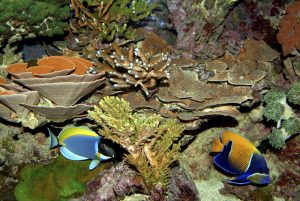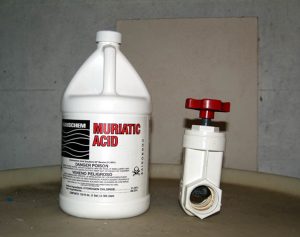For those of you who have been following my editorials know that I have been making changes in my system to help enhance calcification by stony corals. Correcting a too high specific gravity and lowering orthophosphates (PO4) levels by controlling feeding and the use of my refugium to grow great amounts of macroalgae has produced the desired effect – PO4 Levels immeasurable by even a professional Hach test kit (Model PO- 19). These changes have had the desired result; that is, great hermatypic coral growth. See the accompanying picture taken a few days ago. For a very thorough discussion of phosphate in reef aquaria see Randy Holmes-Farley’s column at: http://www.advancedaquarist.com/2002/9/chemistry.
I also keep a high calcium and alkalinity concentration with the continuous use of a calcium reactor and the evening dosing of saturated limewater to replace water evaporation. My system evaporates about 10-gallons of water daily.
It is quite interesting – some might say annoying — how the solution to one problem creates or uncovers another. In my case, I noticed that my down draft skimmer was not collecting enough skimmate and, after closer observation, the foam level in the foam column was too low. Not a problem I thought, ‘I’ll just close down on the output gate valve and thereby raise the foam level.’ However, I soon discovered that the large gate valve was frozen.
I immediately recalled Craig Bingman’s discussions (some personal) about some of the potential problems associated with high calcium and alkalinity concentrations – sand bed clumping and frozen pump parts for example. I had to remove the skimmer from the system, remove the gate valve and disassemble my Iwaki 70-RLT and clean all of the parts that were coated with calcium deposits with Muriatic acid (a 20% solution of HCL). Incidentally, Muriatic acid can be purchased in a hardware store. It is, even at 20%, a very strong acid, much stronger than vinegar. It is very important that one use extreme caution when using this acid – it will burn holes in clothing and severely burn human skin.
The Feature this month was written by my son, Peter Siegel who, aside from exhibiting his own work at various shows, was in charge of digital photography and imaging at the Museum of Natural History in NYC and at Harvard University. He is available to answer technical questions about photography and will critique photos uploaded to the writer’s forum for those who are interested in his opinion.





0 Comments